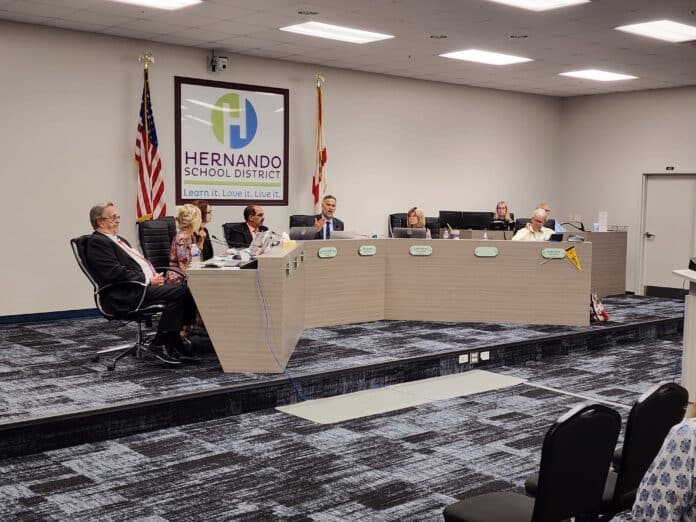On Thursday evening, the school board met with the public at the district office in North Brooksville to hear the people’s concerns and vote on a variety of topics. Despite the lengthy pre-planned agenda that featured 16 items, the focus of the meeting quickly turned to the question of Equal Opportunity Schools.
The goal of EOS is to guarantee that students from historically underrepresented groups and those from low-income backgrounds have access to the same high-quality educational experiences. The Advanced Placement (AP) program, the International Baccalaureate (IB) program and the Advanced International Certificate of Education (AICE) are all examples of such challenging courses. (AICE is the newest of the advanced programs and is an international diploma program created at the University of Cambridge in England. The AICE program is offered at Central High School.)
The decision was anything but a consensus. The board members voted 3-2 to approve the agreement with the Equal Opportunity Schools (EOS) and the purchase of services for all high schools and the issuance of a purchase order in an estimated amount of $83,000. Board members Linda Prescott, Gus Guadagnino, and Susan Duval supported the continuation of the program, while Mark Johnson and Shannon Rodriguez voted to oppose it. After all of the back and forth, what actually are Equal Opportunity Schools?
“Our partnership model is consultative, collaborative, and requires a commitment to specific and measurable results,” the Equal Opportunity Schools’ website stated. “[EOS] has helped nearly 800 schools, 250 districts across 33 states identify students of color and low-income students who qualify for, but are missing from, Advance Placement (AP) or International Baccalaureate (IB) classes. Working together, we successfully enroll them and support their academic success.”
Pastor Jack Martin approached the podium during Citizen Input prior to board discussion and voting. He asked the panel if the policy is based on meritocracy and worried that the program does more harm than good. Martin is concerned they will fall further behind rather than excel if they come from a home that fails to push them toward such goals. The pastor shared an anecdote of his time working at a school. He noted that they would hire private tutors and address the students one-by-one as opposed to the method with which EOS handles it, which he argues “ends up hurting everybody in the process, including that individual.”
Once Item 15 (Equal Opportunity Schools) came up for discussion, the board members pleaded their cases. Shannon Rodriguez opened by calling the policy “a discriminatory program” and dubbed EOS “the law of social physics.” She reasoned that a policy cannot favor one ethnicity while discriminating against another, citing the Supreme Court’s recent ruling on Affirmative Action to support her argument. Mark Johnson echoed Pastor Martin’s sentiment as he opposed “throwing meritocracy out the window” and urged his fellow members to discontinue this policy that has been in effect since the 2019 school year. Johnson cited statistics on the percentage of children who passed their advanced placement exams in 2023 (40 percent) versus 2021 (57 percent). He also reasons that since 40 percent of their students do not go to college, why put them in such a course “where they could be learning a trade by going to some kind of a vocational training?”
In her response, Duval emphasized that EOS is not Affirmative Action and cited her own time in school. She noted how most students were “on tracks,” which generally refers to enrolling students in certain types of courses depending on their abilities or interest level in order to prepare them for a future profession. Putting “students in a box” is unacceptable, she argued. She continued that if parents do not want their children in a class, the children are not forced to remain there. The board member finished her statement by insisting that if they are given that “seed of hope” and they want to run with it, then the student should be allowed regardless of their grades. “We all want to believe in something,” Duval said. Linda Prescott invoked the Constitution in her statement when she reasoned that the Constitution requires equal educational opportunities. Prescott ultimately believes that EOS is the way to provide equality to the county’s students. In her argument, she mirrors Duval’s point that no student should be forced to take a class and states that “students have the right to fail.”
Superintendent of Schools John Stratton wrapped up the EOS portion of the meeting with a couple of points of his own. EOS is paid through federal funding, and the district received over $600,000 back from students taking Advanced Placement tests just in the last year. “It pays for itself; it actually makes money. The return on investment is incredible,” Stratton said. He reiterated that students are not forced to take a class, that taking the class is not the same as receiving college credit, and that the program is not “pulling the kids by race, economic disadvantage, any of that.” Toward the tail end of his response, Stratton touched on the idea of children being excluded due to students with lower GPAs being included by stating, “I also want to be real clear, no one gets passed over if they want to be in [AP courses]… both can go in.”

